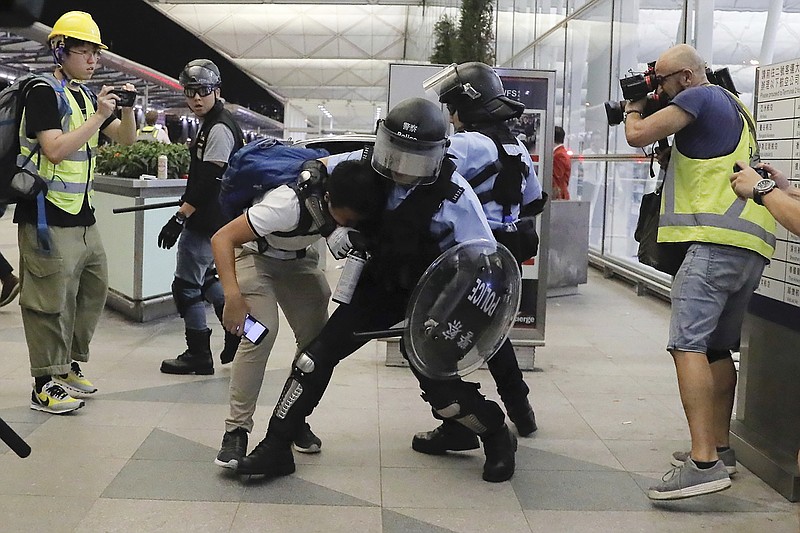HONG KONG (AP) — Riot police clashed briefly with pro-democracy protesters at Hong Kong’s airport Tuesday night in a chaotic end to a second day of demonstrations that caused mass cancellations and disruptions at the Chinese city’s busy transport hub.
Calm eventually returned, with most of the protesters leaving the airport hours after officers armed with pepper spray and swinging batons tried to enter the terminal, fighting with demonstrators who barricaded entrances with luggage carts. Protesters said they planned to return to the airport early today.
The burst of violence also included protesters beating at least two men they suspected of being undercover agents and came the same day Hong Kong’s pro-Beijing leader warned the demonstrators had pushed events onto a “path of no return,” highlighting the hardening positions on both sides.
Police took away several people they caught outside the arrival hall and eventually retreated.
Police said they were trying to help ambulance officers reach an injured man whom protesters had cornered and detained for about two hours on suspicion of being an undercover agent from mainland China. Rescuers eventually succeeded in getting him to an ambulance, local broadcaster RTHK reported.
Protesters then detained and beat a second man whom they also suspected of being an undercover agent.
After a brief period when planes were able to take off and land early in the day, authorities were forced to cancel the remaining flights. The airport authority suspended check-in services for departing flights as of 4:30 p.m., with departing flights that had completed the process able to continue to operate.
The airport’s website showed at least 120 cancellations and it advised people not to come to the airport, one of the world’s busiest.
More than 200 flights were canceled Monday and passengers were forced to stay in the city while airlines tried to find other ways to get them to their destinations.
The airport disruptions escalated a summer of demonstrations aimed at what many Hong Kong residents see as an increasing erosion of the freedoms they were promised in 1997 when Communist Party-ruled mainland China took over what had been a British colony.
The protests have built on an opposition movement that shut down much of the city for seven weeks in 2014 before it eventually fizzled and its leaders were jailed on public disturbance charges.
The central government in Beijing has ominously characterized the current protest movement as something approaching “terrorism” that poses an “existential threat” to citizens.
While Beijing tends to define terrorism broadly, extending it especially to nonviolent movements opposing government policies in minority regions such as Tibet and Xinjiang, its use of the term in relation to Hong Kong raised the prospect of greater violence and the possible suspension of legal rights for those detained.
Hong Kong leader Carrie Lam said the instability, chaos and violence have placed the city on a “path of no return.”
The black-clad demonstrators have shown no sign of letting up on their campaign to force Lam’s administration to respond to their demands, including that she step down and scrap proposed legislation under which some suspects could be sent to mainland China, where critics say they could face torture and unfair or politically charged trials.
Lam has rejected calls for dialogue, part of what analysts say is a strategy to wear down the opposition movement through police action while prompting demonstrators to take more violent and extreme actions that will turn the public against them. At the airport, protesters discussed among themselves whether they should simply block all access to the facility.
Meanwhile, paramilitary police were assembling across the border in the city of Shenzhen for exercises that some saw as a threat to increase force against the mostly young protesters who have turned out by the thousands in the past 10 weeks.
President Donald Trump tweeted U.S. intelligence believes the Chinese government is moving troops to its border with Hong Kong. He also tweeted that “Everyone should be calm and safe!” He provided no additional details.
While China has yet to threaten using the army — as it did against pro-democracy protesters in Beijing in 1989 — the Shenzhen exercises were a sign of its ability to crush the demonstrations, even at the cost to Hong Kong’s reputation as a safe haven for business and international exchange. Images on the internet showed armored personnel carriers belonging to the People’s Armed Police driving in a convoy Monday toward the site of the exercises.
The People’s Liberation Army has a garrison in Hong Kong, which recently released a video showing its units combating actors dressed as protesters. Hong Kong police also put on a display of water cannons.
Police have arrested more than 700 protesters since June and say they have infiltrated the movement, leading to concerns officers were inciting violence. Scores of protesters and police have been hurt, including a woman reported to have had an eye ruptured by a beanbag round fired by police during clashes Sunday.
Police said they are investigating the incident, which protesters have taken up as a rallying cry. Some in the airport occupation wore gauze bandages dyed with artificial blood over one eye.

